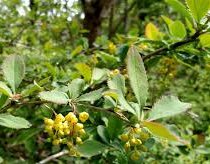Barberry Bark

Several varieties of berberis have been researched and scientists find that they have similar benefits:
- Barbery bark contains berberine which promotes strong immune-specific protection - it is considered to have antimicrobial qualities against many microorganisms including bacteria, viruses, fungi, protozoans, helminths, and chlamydia.1
- Berberis lycium has strong effects against E. coli.3.
- Predominant uses of berberine include bacterial diarrhea, intestinal parasite infections, and ocular trachoma infections.
- Berberis vulgaris has yielded compounds with antioxidant (cannabisin G and (+/-)-lyoniresinol) and cytoprotective (protects cells) (cannabisin G).2
- It protects again fungal infections, yeast, parasites, and bacterial/viral infections
- Berberis aristata has been used for eye and ear infections, as well as other conditions due to its anti-pyretic, anti-bacterial, anti-microbial, anti-hepatotoxic, anti-hyperglycaemic, anti-cancer, anti-oxidant, and anti-lipidemic capacity 4
Footnotes
1. [No author]. (2000). Berberine. Altern Med Rev. Apr;5(2):175-7.
2. Tomosaka H, Chin YW, Salim AA, Keller WJ, Chai H, et al. (2008). Antioxidant and cytoprotective compounds from
Berberis vulgaris (barberry). Phytother Res. Jul;22(7)979-81.
3. Malik TA, Kamili AN, Chisthi MZ, Ahad S, Tantry MA, et al. (2017). Breaking the resistance of Escherichia coli:
Antimicrobial activity of Berberis lycium Royle. Microb Pathog. Jan;102:12-20.
4. Poldar D, Hirwani RR, Dhulap S. (2012). Phyto-chemical and pharmacological applications of Berberis aristata. Fitoterapia. Jul;83(5):817-30.
 info@naturaleyecare.com
info@naturaleyecare.com



 Home
Home



 Vision
Vision Vision
Vision



 Health
Health Health
Health Research/Services
Research/Services Pets
Pets About/Contact
About/Contact


